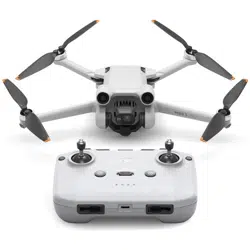Loading ...
Loading ...
Loading ...

©
2022 DJI All Rights Reserved.
27
DJI Mini 3 Pro
User Manual
orientation and gimbal.
Follow the steps below to use Course Lock:
1. Set the interval time, video duration, and max speed. The screen displays the number of photos that
will be taken and the shooting duration.
2. Set a ight direction.
3. If applicable, drag-select a subject. Use the gimbal dial and pan stick to adjust the frame.
4. Tap the shutter/record button to begin. Move the pitch stick and roll stick to control the horizontal
ight speed and briey alter the aircraft orientation. Move the throttle stick to control the vertical ight
speed.
Waypoints
The aircraft automatically takes photos on a flight path of two to five waypoints and generates a
timelapse video. The aircraft can y in sequence from waypoints 1 to 5 or 5 to 1.
Follow the steps below to use Waypoints:
1. Set the desired waypoints and the lens direction.
2. Set the interval time and video duration. The screen displays the number of photos that will be taken
and the shooting duration.
3. Tap the shutter/record button to begin.
The aircraft will generate a timelapse video automatically, which is viewable in playback. In the camera
settings, users can choose whether to save the footage in JPEG or RAW format and to store it in the
internal storage or the microSD card. If needed, it is recommended to store the footage in the microSD
card.
For optimal performance, use Hyperlapse at an altitude higher than 50 m and set a dierence of at
least two seconds between the interval time and shutter.
It is recommended to select a static subject (e.g., high-rise buildings, mountainous terrain) located
at a safe distance from the aircraft (further than 15 m). Do not select a subject that is too near the
aircraft.
When the lighting is sufficient and the environment is suitable for the vision systems to operate,
the aircraft will brake and hover in place if an obstacle is detected in front, behind or below during
Hyperlapse. Note that obstacles cannot be detected on either side of the aircraft. If the lighting
becomes insufficient or the environment is unsuitable for the vision systems to operate during
Hyperlapse, the aircraft will continue shooting without obstacle avoidance. Fly with caution.
The aircraft will only generate a video after at least 25 photos have been taken, which is the amount
required to generate a one-second video. The video will be generated by default regardless of
whether Hyperlapse concludes normally or the aircraft exits from the mode unexpectedly (such as
when Low Battery RTH is triggered).
Advanced Pilot Assistance Systems (APAS 4.0)
The Advanced Pilot Assistance Systems 4.0 (APAS 4.0) feature is available in Normal mode and Cine
mode. When APAS is enabled, the aircraft will continue to respond to user commands and plan its
path according to both control stick inputs and the ight environment. APAS makes it easier to avoid
obstacles, obtain smoother footage, and gives a better ying experience.
Loading ...
Loading ...
Loading ...
